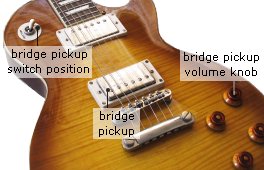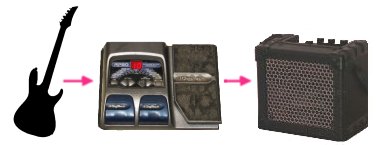Getting the Right Sound for Riffing
In this article I explain how to get a decent guitar tone that is suitable for playing Rock and Metal riffs that you're about to learn in my following riff lessons.
Having a proper guitar sound is crucial!
When you have an impressive sound, even simple riffs will come out punchy and cool, on the other hand, a poor sound will spoil your playing every time no matter what and how well you perform.
Guitar pickup switch and volume knob
First things first, if you want to get a more edgy tone for riffing, switch to the bridge pickup and turn the volume knob to max.

put the switch down.

Note!
When you turn the volume knob on a guitar down, along with the volume you actually decrease the gain of a distortion effect too.
The distortion effect
The distortion is the core of electric guitar sound.
If you don't know what a distorted guitar means check out two audio examples of:
Feel the difference?
Note that often you will hear the distortion referred as an overdrive, dist, or "dirty" sound.
Actually the overdrive is a bit different effect from the distortion. The overdrive has lower gain, resulting in milder sound that is more suitable for playing blues and classic rock music. When the distortion produces harsher and harder sound, more suitable for hard-rock and metal music.
A few ways to get a distorted sound:
1. Using distortion built into the guitar combo amp.
Guitar combo amp is the combination of an amplifier and a speaker in one single unit.

A modern guitar combo has at least two channels: one for dry (clean) tone, and the second is overdriven or distorted channel.
2. Putting a stand-along distortion pedal between the guitar and the guitar amp is another way to get the "dirty" sound.

It can be useful if your amp has too mild overdrive that doesn't provide enough kick.
Note that a guitar plugged into the guitar combo amp will sound a lot better than a guitar plugged into a distortion pedal connected to a home stereo system instead.
It's because the guitar combo is designed specifically for an electric guitar with necessary frequency range and impedance in mind.
3. Another option to get a distorted guitar is to plug your instrument into a guitar multi-effects processor.
Many of these devices have a "guitar speaker emulation" that allows them to be connected to a home stereo system without sound degradation.
While multi-effects processors are incredibly versatile tools, having plenty of different distortions as well as tons of other effects in one single unit. Often stand-alone analog distortion guitar effect pedals sound more genuine.
The reason behind this is actually that a pedal has a real electric circuit that creates the clipping inside the diodes, transistors or valves. While multi-effects processors just emulate this circuit using digital technology.
I really couldn't hear much difference when playing riffs on high gain settings, but the difference becomes more audible when I play guitar solos using smooth distortion effect.
Anyway a multi-effects processor is a great thing when you're learning to play, they are relatively cheap and you don't need anything else to get going.
If you're going to use a guitar combo for your practicing you'd need at least 10-Watts or 15-Watts of guitar amp power, and more to get a decent tone at home.
Note that guitar amps are much louder than a stereo systems with the same number of watts. A 10-watt combo can produce enough noise to start bothering your neighbours, 30-watt amp already can make them very angry with you. So be careful with the volume.
Another difference between these two amps would be the depth of the sound they produce. Of course 30-watt amp will sound more profound.
Equalizer (EQ)
Many guitar amps with a power of 15w or more has at least three EQ knobs - bass, middle and treble.
By tweaking EQ knobs alone you can shape your guitar's tone substantially to match your taste.
Here's a few practical EQ settings:
Rock

Metal

Extreme Metal

Reverb
This effect is useful to add more depth to the tone.
Reverb creates the effect like you play in a big room, and you may hear fading trails of sounds right after your playing.
It's something similar to what a sound hole in an acoustic guitar makes, but with an electronic device you can widely change the amount of the reverb and its decay.
Some guitar combo amps have Reverb effect on board, such as Fender Frontman 15R and 25R, Marshall MG15CDR and others. Letter R in the name of an amp usually stays for Reverb.
caveat!
The reverb effect should be plugged after the distortion, putting it before will blemish the sound.
It can be a problem if you use built in distortion on your amp and your amp doesn't have the Reverb effect or effects loop. In this case there's no place to plug the reverb into in the right way.
The solution is to get stand-alone distortion and reverb pedals, plug the distortion into the reverb, and the reverb into the guitar input on your amp.

Another option is just to get the digital multi-effects unit, and plug it into the amp.

The guitar effects is a broad and complex topic. If you're going to buy some pedal while not being sure where to place it or where it will work with your particular setup you may throw your money away.
Better ask me your concern before you decide to buy.
You can contact me via this page.
If you're planning to use several different guitar effect pedals or software effects simultaneously, let's say the Distortion, Delay and Chorus, take a look at: Guitar Effect Ordering article to get your effects in the right sequence, otherwise your sound might suffer from misplacements.
If you're curious what other sounds you can achieve by playing around different guitar effects, check out the Guitar Effect Combinations page where I've put a number of audio examples and described how to sound like them.
Following Articles:
